Module 1 Lost and found Unit 1 Whose bag is this? 知识点练习课件33张PPT
文档属性
| 名称 | Module 1 Lost and found Unit 1 Whose bag is this? 知识点练习课件33张PPT | 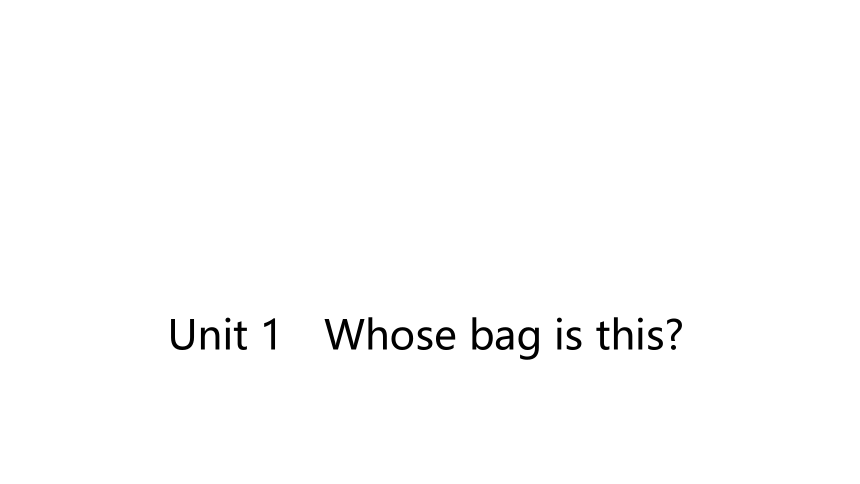 | |
| 格式 | zip | ||
| 文件大小 | 179.4KB | ||
| 资源类型 | 教案 | ||
| 版本资源 | 外研版 | ||
| 科目 | 英语 | ||
| 更新时间 | 2020-01-07 21:01:47 | ||
图片预览

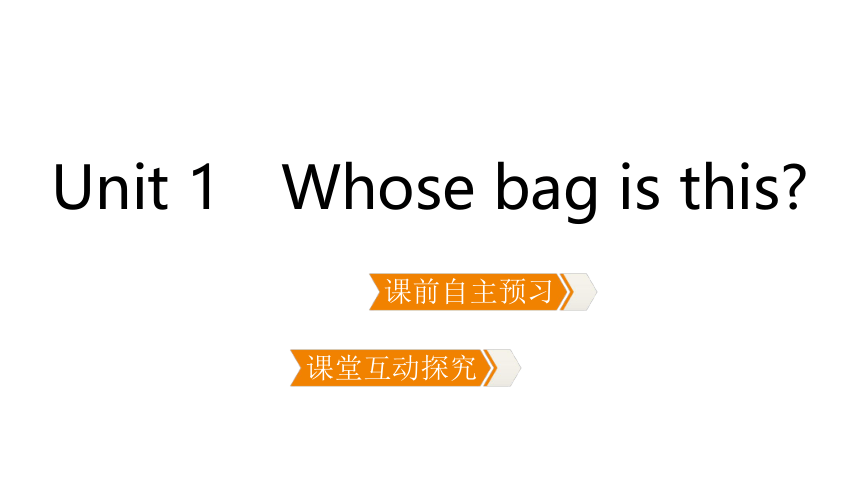
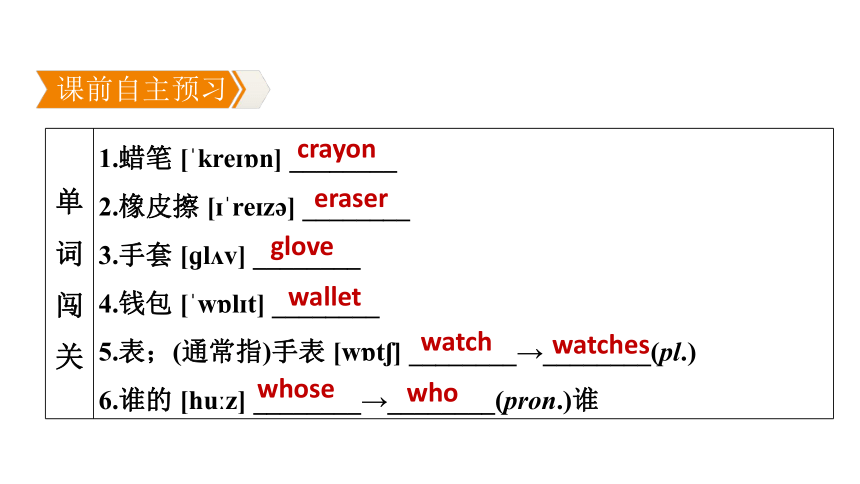
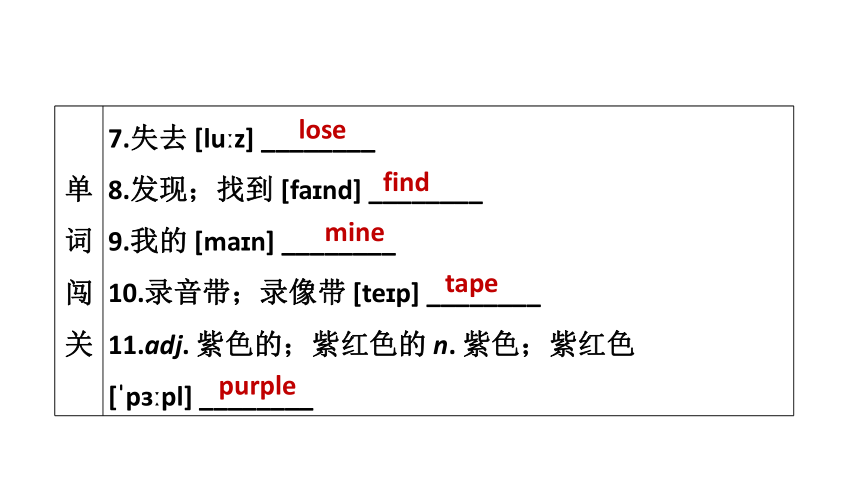

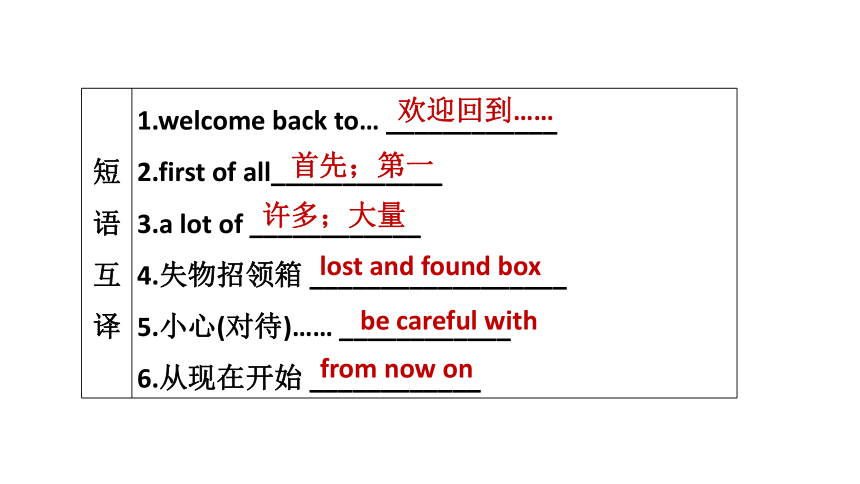
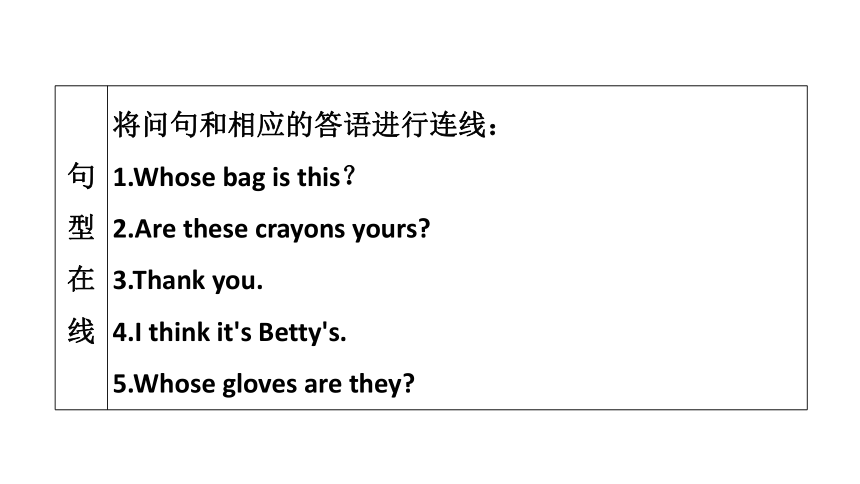
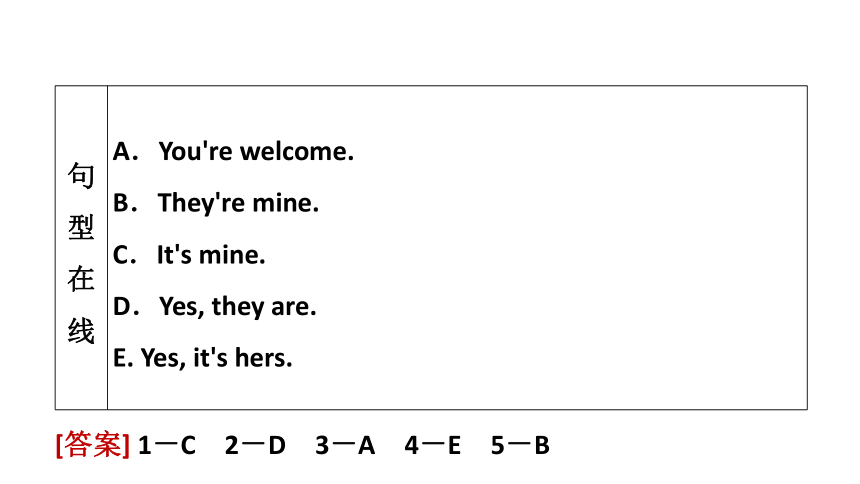
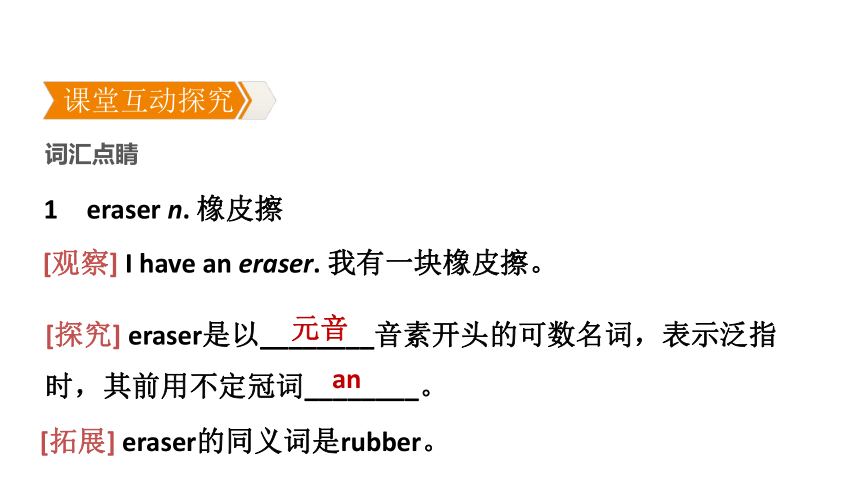

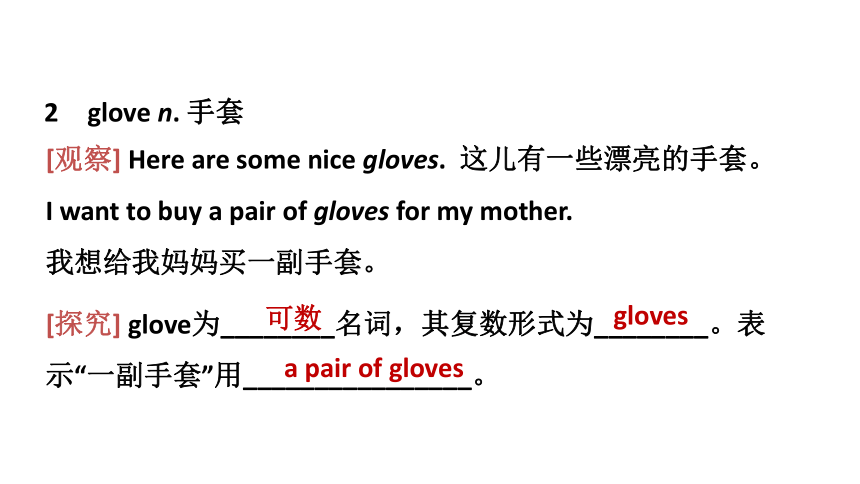

文档简介
课件33张PPT。Module 1 Lost and foundUnit 1 Whose bag is this?Module 1 Lost an foundUnit 1 Whose bag is this?课前自主预习 课堂互动探究 课前自主预习 crayoneraserglovewalletwatchwatcheswhosewhofindminetapelosepurpleyouryouyouyourshersher sheher欢迎回到……首先;第一许多;大量lost and found boxbe careful withfrom now on[答案] 1-C 2-D 3-A 4-E 5-B课堂互动探究 词汇点睛1 eraser n. 橡皮擦[观察] I have an eraser. 我有一块橡皮擦。[探究] eraser是以________音素开头的可数名词,表示泛指时,其前用不定冠词________。元音an[拓展] eraser的同义词是rubber。活学活用1.There is ________ eraser in the lost and found box. Is it yours?
A. a B. an
C. the D. /B2 glove n. 手套[观察] Here are some nice gloves. 这儿有一些漂亮的手套。
I want to buy a pair of gloves for my mother.
我想给我妈妈买一副手套。[探究] glove为________名词,其复数形式为________。表示“一副手套”用________________。可数glovesa pair of gloves[拓展] “数词+pair(s) of+可数名词复数”在句中作主语时,谓语动词的单复数取决于pair的单复数。例如:
Two pairs of gloves are on the desk. 书桌上有两副手套。活学活用2.There ________ a pair of shoes under the bed. The shoes ________ my brother's.
A.is; is B.are; are
C.are; is D.is; areD3 whose pron. 谁的[观察] Whose bag is this? 这是谁的包?
Whose are these sweaters? 这些毛衣是谁的?[探究] whose是疑问代词,常用于____________句,意为“谁的”。特殊疑问[拓展] (1)whose用来提问形容词性物主代词、名词性物主代词或名词所有格。当被提问部分作定语时,用“Whose+名词+一般疑问句?”结构;当被提问部分作表语时,用“Whose+一般疑问句?”结构。例如:
It's my shirt. 它是我的衬衫。
→Whose shirt is this? 这是谁的衬衫?
That shirt is mine. 那件衬衫是我的。
→Whose is that shirt? 那件衬衫是谁的?(2)who意为“谁”,用来询问姓名或与某人的关系。who's是who和is的缩略形式,意为“谁是”。例如:
—Who is/Who's the boy? 这个男孩是谁?
—He is John. 他是约翰。活学活用3.2018·武威 ________pencil is this, Tom's or Henry's?
A.What B.When
C.Who D.WhoseD4 welcome v. 欢迎 adj. 受欢迎的[观察] Welcome back to school, everyone!欢迎大家回到学校!
You're welcome! 别客气![探究] welcome的两种词性:[拓展] welcome to 后接表示地点的副词时,介词to应省略。例如:
Welcome home, children!孩子们,欢迎回家!活学活用4.—Thanks for your help.
—________.
A.Don't thank me
B.You're welcome
C.Right
D.You're rightB5 first of all首先;第一[观察] First of all, come and look in the lost and found box!
首先,过来看看失物招领箱吧![探究] first of all指时间、次序上的“首先;第一”。其他表示顺序的单词或短语还有second(第二;其次); next(接下来); then(然后); finally/at last(最后)等。[拓展] at first意为“起初;起先”,相当于in the beginning。活学活用5.There are many things to do in today's class. ________, let's listen to the tape.
A.At one time B.At last
C.First of all D.Every dayC[解析]考查固定短语。句意:在今天的课上有许多事情要做。首先让我们听录音。at one time意为“曾经”;at last意为“最后”;first of all意为“首先”;every day意为“每天”。根据句意判断这里表示“首先”。故选C。6 careful adj. 仔细的;认真的;小心的[观察] Everyone, please be careful with your things from now on.
从现在开始,请每个人小心保管自己的物品。[探究] careful作形容词,意为“仔细的;认真的;小心的”,常见搭配是________________,意为“小心(对待)……”。be careful with[拓展] careful的常见搭配:6.(1)过马路时,要注意车辆。
______ ______ ______ the traffic when you cross the road.
(2)请小心对待我的汽车。
Please ________ ________ ________ my car.Be careful of/aboutbe careful with活学活用句型透视1 Here's a purple wallet! 这儿有一个紫色的钱包!
Here are some nice gloves. 这儿有一些漂亮的手套。[探究] “Here be…”是倒装结构,意为“这儿有……”,其中be动词的单复数要根据be后的名词的单复数来确定,单数可数名词或不可数名词用is,复数可数名词用are。例如:
Here is a book for you. 这儿有你的一本书。
Here are some of my family photos. 这儿有我的一些家庭照片。1.用be动词的适当形式填空
(1)Here ________ an eraser and some crayons.
(2)Here ________ my gloves.Would you like to try them on?
(3)Here ________ some bread. You can eat a piece(片).活学活用isareis2 I think it's Betty's.
我认为它是贝蒂的。[探究]此句是主从复合句,“I think”是主句,“it's Betty's”是宾语从句。“I think+宾语从句”经常用来表达说话者的观点、看法,语气较为委婉。例如:
I think English is very important to us.
我认为英语对我们来说非常重要。[注意]在“I think+宾语从句”中,如果要否定后面的从句,需要把否定词提前,即“I don't think+宾语从句”,这叫作“否定前移”。例如:
I don't think she can play the piano.
我认为她不会弹钢琴。2.按要求完成下列各题
(1)我认为那本书有趣。(翻译句子)
______________________________________________________
(2)I think it is a bird. (改为否定句)
I ________ think it ________ a bird.I think that book is interesting.don'tis活学活用
谢 谢 观 看!
A. a B. an
C. the D. /B2 glove n. 手套[观察] Here are some nice gloves. 这儿有一些漂亮的手套。
I want to buy a pair of gloves for my mother.
我想给我妈妈买一副手套。[探究] glove为________名词,其复数形式为________。表示“一副手套”用________________。可数glovesa pair of gloves[拓展] “数词+pair(s) of+可数名词复数”在句中作主语时,谓语动词的单复数取决于pair的单复数。例如:
Two pairs of gloves are on the desk. 书桌上有两副手套。活学活用2.There ________ a pair of shoes under the bed. The shoes ________ my brother's.
A.is; is B.are; are
C.are; is D.is; areD3 whose pron. 谁的[观察] Whose bag is this? 这是谁的包?
Whose are these sweaters? 这些毛衣是谁的?[探究] whose是疑问代词,常用于____________句,意为“谁的”。特殊疑问[拓展] (1)whose用来提问形容词性物主代词、名词性物主代词或名词所有格。当被提问部分作定语时,用“Whose+名词+一般疑问句?”结构;当被提问部分作表语时,用“Whose+一般疑问句?”结构。例如:
It's my shirt. 它是我的衬衫。
→Whose shirt is this? 这是谁的衬衫?
That shirt is mine. 那件衬衫是我的。
→Whose is that shirt? 那件衬衫是谁的?(2)who意为“谁”,用来询问姓名或与某人的关系。who's是who和is的缩略形式,意为“谁是”。例如:
—Who is/Who's the boy? 这个男孩是谁?
—He is John. 他是约翰。活学活用3.2018·武威 ________pencil is this, Tom's or Henry's?
A.What B.When
C.Who D.WhoseD4 welcome v. 欢迎 adj. 受欢迎的[观察] Welcome back to school, everyone!欢迎大家回到学校!
You're welcome! 别客气![探究] welcome的两种词性:[拓展] welcome to 后接表示地点的副词时,介词to应省略。例如:
Welcome home, children!孩子们,欢迎回家!活学活用4.—Thanks for your help.
—________.
A.Don't thank me
B.You're welcome
C.Right
D.You're rightB5 first of all首先;第一[观察] First of all, come and look in the lost and found box!
首先,过来看看失物招领箱吧![探究] first of all指时间、次序上的“首先;第一”。其他表示顺序的单词或短语还有second(第二;其次); next(接下来); then(然后); finally/at last(最后)等。[拓展] at first意为“起初;起先”,相当于in the beginning。活学活用5.There are many things to do in today's class. ________, let's listen to the tape.
A.At one time B.At last
C.First of all D.Every dayC[解析]考查固定短语。句意:在今天的课上有许多事情要做。首先让我们听录音。at one time意为“曾经”;at last意为“最后”;first of all意为“首先”;every day意为“每天”。根据句意判断这里表示“首先”。故选C。6 careful adj. 仔细的;认真的;小心的[观察] Everyone, please be careful with your things from now on.
从现在开始,请每个人小心保管自己的物品。[探究] careful作形容词,意为“仔细的;认真的;小心的”,常见搭配是________________,意为“小心(对待)……”。be careful with[拓展] careful的常见搭配:6.(1)过马路时,要注意车辆。
______ ______ ______ the traffic when you cross the road.
(2)请小心对待我的汽车。
Please ________ ________ ________ my car.Be careful of/aboutbe careful with活学活用句型透视1 Here's a purple wallet! 这儿有一个紫色的钱包!
Here are some nice gloves. 这儿有一些漂亮的手套。[探究] “Here be…”是倒装结构,意为“这儿有……”,其中be动词的单复数要根据be后的名词的单复数来确定,单数可数名词或不可数名词用is,复数可数名词用are。例如:
Here is a book for you. 这儿有你的一本书。
Here are some of my family photos. 这儿有我的一些家庭照片。1.用be动词的适当形式填空
(1)Here ________ an eraser and some crayons.
(2)Here ________ my gloves.Would you like to try them on?
(3)Here ________ some bread. You can eat a piece(片).活学活用isareis2 I think it's Betty's.
我认为它是贝蒂的。[探究]此句是主从复合句,“I think”是主句,“it's Betty's”是宾语从句。“I think+宾语从句”经常用来表达说话者的观点、看法,语气较为委婉。例如:
I think English is very important to us.
我认为英语对我们来说非常重要。[注意]在“I think+宾语从句”中,如果要否定后面的从句,需要把否定词提前,即“I don't think+宾语从句”,这叫作“否定前移”。例如:
I don't think she can play the piano.
我认为她不会弹钢琴。2.按要求完成下列各题
(1)我认为那本书有趣。(翻译句子)
______________________________________________________
(2)I think it is a bird. (改为否定句)
I ________ think it ________ a bird.I think that book is interesting.don'tis活学活用
谢 谢 观 看!
同课章节目录
- Module 1 Lost and found
- Unit 1 Whose bag is this?
- Unit 2 Are they yours?
- Unit 3 Language in use
- Module 2 What can you do ?
- Unit 1 I can play the piano
- Unit 2 I can run really fast
- Unit 3 Language in use
- Module 3 Making plans
- Unit 1 What are you going to do at the weekends?
- Unit 2 We're going to cheer the players.
- Unit 3 Language in use
- Module 4 Life in the future
- Unit 1 Everyone will study at home
- Unit 2 Every family will have a small plane.
- Unit 3 Language in use
- Module 5 Shopping
- Unit 1 What can I do for you?
- Unit 2 You can buy everything on the Internet
- Unit 3 Language in use
- Module 6 Around town
- Unit 1 Could you tell me how to get to the Nationa
- Unit 2 The London Eye is on your right.
- Unit 3 Language in use
- Revision module A
- Module 7 My past life
- Unit 1 I was born in a small village.
- Unit 2 I was born in Quincy.
- Unit 3 Language in use
- Module 8 Story time
- Unit 1 Once upon a time….
- Unit 2 Goldilocks hurried out of the house.
- Unit 3 Language in use
- Module 9 Life history
- Unit 1 He left school and began work at the age of
- Unit 2 He decided to be an actor.
- Unit 3 Language in use
- Module 10 A holiday journey
- Unit 1 What did you do?
- Unit 2 This morning we took a walk.
- Unit 3 Language in use
- Module 11 Body language
- Unit 1 They touch noses!
- Unit 2 Here are some ways to welcome them.
- Unit 3 Language in use
- Module 12 Western music
- Unit 1 It's so beautiful!
- Unit 2 Vienna is the centre of European classical
- Unit 3 Language in use
- Revision module B
